Functional Behavior Assessment 2022
VerifiedAdded on 2022/09/27
|16
|4744
|37
AI Summary
Contribute Materials
Your contribution can guide someone’s learning journey. Share your
documents today.
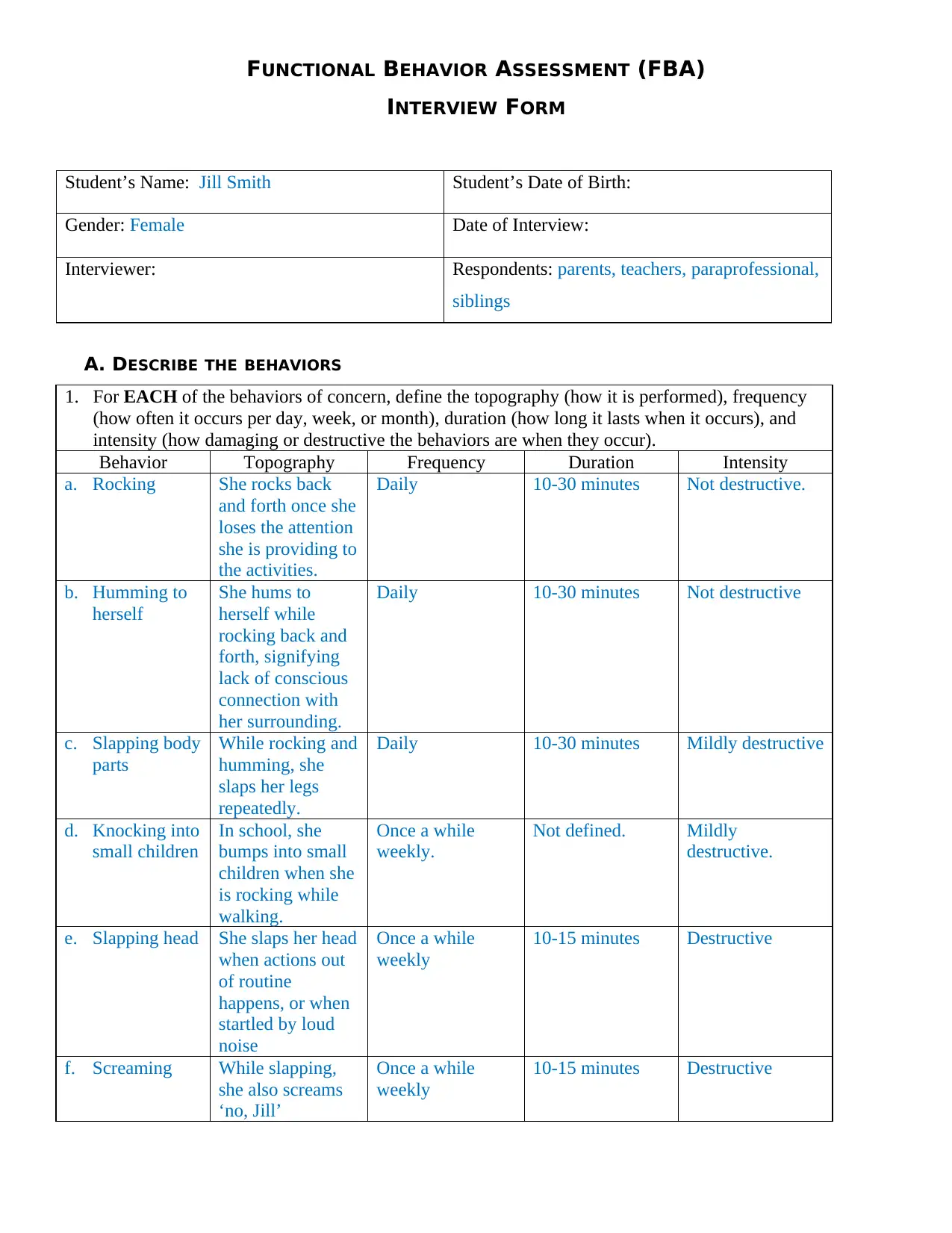
FUNCTIONAL BEHAVIOR ASSESSMENT (FBA)
INTERVIEW FORM
Student’s Name: Jill Smith Student’s Date of Birth:
Gender: Female Date of Interview:
Interviewer: Respondents: parents, teachers, paraprofessional,
siblings
A. DESCRIBE THE BEHAVIORS
1. For EACH of the behaviors of concern, define the topography (how it is performed), frequency
(how often it occurs per day, week, or month), duration (how long it lasts when it occurs), and
intensity (how damaging or destructive the behaviors are when they occur).
Behavior Topography Frequency Duration Intensity
a. Rocking She rocks back
and forth once she
loses the attention
she is providing to
the activities.
Daily 10-30 minutes Not destructive.
b. Humming to
herself
She hums to
herself while
rocking back and
forth, signifying
lack of conscious
connection with
her surrounding.
Daily 10-30 minutes Not destructive
c. Slapping body
parts
While rocking and
humming, she
slaps her legs
repeatedly.
Daily 10-30 minutes Mildly destructive
d. Knocking into
small children
In school, she
bumps into small
children when she
is rocking while
walking.
Once a while
weekly.
Not defined. Mildly
destructive.
e. Slapping head She slaps her head
when actions out
of routine
happens, or when
startled by loud
noise
Once a while
weekly
10-15 minutes Destructive
f. Screaming While slapping,
she also screams
‘no, Jill’
Once a while
weekly
10-15 minutes Destructive
INTERVIEW FORM
Student’s Name: Jill Smith Student’s Date of Birth:
Gender: Female Date of Interview:
Interviewer: Respondents: parents, teachers, paraprofessional,
siblings
A. DESCRIBE THE BEHAVIORS
1. For EACH of the behaviors of concern, define the topography (how it is performed), frequency
(how often it occurs per day, week, or month), duration (how long it lasts when it occurs), and
intensity (how damaging or destructive the behaviors are when they occur).
Behavior Topography Frequency Duration Intensity
a. Rocking She rocks back
and forth once she
loses the attention
she is providing to
the activities.
Daily 10-30 minutes Not destructive.
b. Humming to
herself
She hums to
herself while
rocking back and
forth, signifying
lack of conscious
connection with
her surrounding.
Daily 10-30 minutes Not destructive
c. Slapping body
parts
While rocking and
humming, she
slaps her legs
repeatedly.
Daily 10-30 minutes Mildly destructive
d. Knocking into
small children
In school, she
bumps into small
children when she
is rocking while
walking.
Once a while
weekly.
Not defined. Mildly
destructive.
e. Slapping head She slaps her head
when actions out
of routine
happens, or when
startled by loud
noise
Once a while
weekly
10-15 minutes Destructive
f. Screaming While slapping,
she also screams
‘no, Jill’
Once a while
weekly
10-15 minutes Destructive
Secure Best Marks with AI Grader
Need help grading? Try our AI Grader for instant feedback on your assignments.
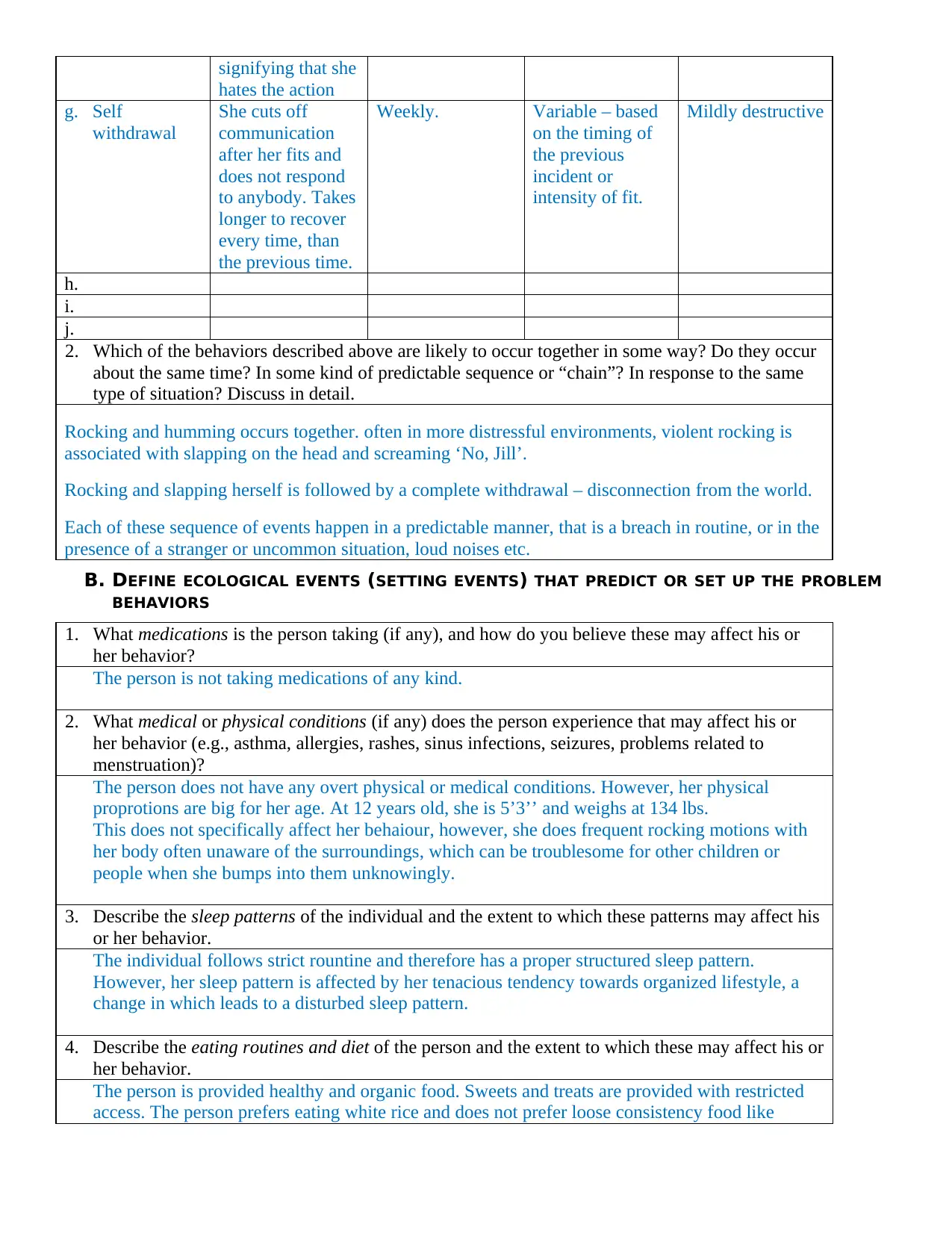
signifying that she
hates the action
g. Self
withdrawal
She cuts off
communication
after her fits and
does not respond
to anybody. Takes
longer to recover
every time, than
the previous time.
Weekly. Variable – based
on the timing of
the previous
incident or
intensity of fit.
Mildly destructive
h.
i.
j.
2. Which of the behaviors described above are likely to occur together in some way? Do they occur
about the same time? In some kind of predictable sequence or “chain”? In response to the same
type of situation? Discuss in detail.
Rocking and humming occurs together. often in more distressful environments, violent rocking is
associated with slapping on the head and screaming ‘No, Jill’.
Rocking and slapping herself is followed by a complete withdrawal – disconnection from the world.
Each of these sequence of events happen in a predictable manner, that is a breach in routine, or in the
presence of a stranger or uncommon situation, loud noises etc.
B. DEFINE ECOLOGICAL EVENTS (SETTING EVENTS) THAT PREDICT OR SET UP THE PROBLEM
BEHAVIORS
1. What medications is the person taking (if any), and how do you believe these may affect his or
her behavior?
The person is not taking medications of any kind.
2. What medical or physical conditions (if any) does the person experience that may affect his or
her behavior (e.g., asthma, allergies, rashes, sinus infections, seizures, problems related to
menstruation)?
The person does not have any overt physical or medical conditions. However, her physical
proprotions are big for her age. At 12 years old, she is 5’3’’ and weighs at 134 lbs.
This does not specifically affect her behaiour, however, she does frequent rocking motions with
her body often unaware of the surroundings, which can be troublesome for other children or
people when she bumps into them unknowingly.
3. Describe the sleep patterns of the individual and the extent to which these patterns may affect his
or her behavior.
The individual follows strict rountine and therefore has a proper structured sleep pattern.
However, her sleep pattern is affected by her tenacious tendency towards organized lifestyle, a
change in which leads to a disturbed sleep pattern.
4. Describe the eating routines and diet of the person and the extent to which these may affect his or
her behavior.
The person is provided healthy and organic food. Sweets and treats are provided with restricted
access. The person prefers eating white rice and does not prefer loose consistency food like
hates the action
g. Self
withdrawal
She cuts off
communication
after her fits and
does not respond
to anybody. Takes
longer to recover
every time, than
the previous time.
Weekly. Variable – based
on the timing of
the previous
incident or
intensity of fit.
Mildly destructive
h.
i.
j.
2. Which of the behaviors described above are likely to occur together in some way? Do they occur
about the same time? In some kind of predictable sequence or “chain”? In response to the same
type of situation? Discuss in detail.
Rocking and humming occurs together. often in more distressful environments, violent rocking is
associated with slapping on the head and screaming ‘No, Jill’.
Rocking and slapping herself is followed by a complete withdrawal – disconnection from the world.
Each of these sequence of events happen in a predictable manner, that is a breach in routine, or in the
presence of a stranger or uncommon situation, loud noises etc.
B. DEFINE ECOLOGICAL EVENTS (SETTING EVENTS) THAT PREDICT OR SET UP THE PROBLEM
BEHAVIORS
1. What medications is the person taking (if any), and how do you believe these may affect his or
her behavior?
The person is not taking medications of any kind.
2. What medical or physical conditions (if any) does the person experience that may affect his or
her behavior (e.g., asthma, allergies, rashes, sinus infections, seizures, problems related to
menstruation)?
The person does not have any overt physical or medical conditions. However, her physical
proprotions are big for her age. At 12 years old, she is 5’3’’ and weighs at 134 lbs.
This does not specifically affect her behaiour, however, she does frequent rocking motions with
her body often unaware of the surroundings, which can be troublesome for other children or
people when she bumps into them unknowingly.
3. Describe the sleep patterns of the individual and the extent to which these patterns may affect his
or her behavior.
The individual follows strict rountine and therefore has a proper structured sleep pattern.
However, her sleep pattern is affected by her tenacious tendency towards organized lifestyle, a
change in which leads to a disturbed sleep pattern.
4. Describe the eating routines and diet of the person and the extent to which these may affect his or
her behavior.
The person is provided healthy and organic food. Sweets and treats are provided with restricted
access. The person prefers eating white rice and does not prefer loose consistency food like
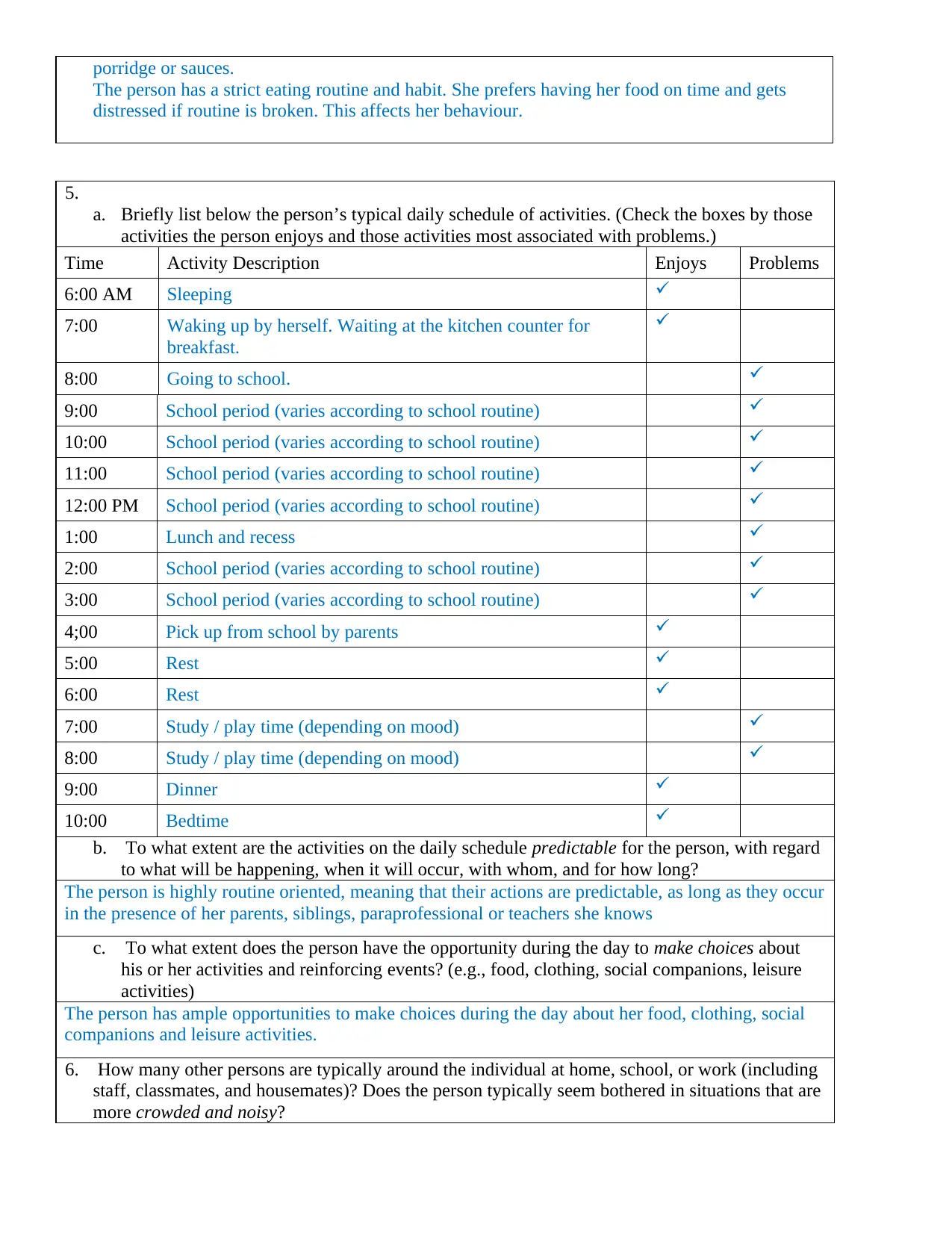
porridge or sauces.
The person has a strict eating routine and habit. She prefers having her food on time and gets
distressed if routine is broken. This affects her behaviour.
5.
a. Briefly list below the person’s typical daily schedule of activities. (Check the boxes by those
activities the person enjoys and those activities most associated with problems.)
Time Activity Description Enjoys Problems
6:00 AM Sleeping
7:00 Waking up by herself. Waiting at the kitchen counter for
breakfast.
8:00 Going to school.
9:00 School period (varies according to school routine)
10:00 School period (varies according to school routine)
11:00 School period (varies according to school routine)
12:00 PM School period (varies according to school routine)
1:00 Lunch and recess
2:00 School period (varies according to school routine)
3:00 School period (varies according to school routine)
4;00 Pick up from school by parents
5:00 Rest
6:00 Rest
7:00 Study / play time (depending on mood)
8:00 Study / play time (depending on mood)
9:00 Dinner
10:00 Bedtime
b. To what extent are the activities on the daily schedule predictable for the person, with regard
to what will be happening, when it will occur, with whom, and for how long?
The person is highly routine oriented, meaning that their actions are predictable, as long as they occur
in the presence of her parents, siblings, paraprofessional or teachers she knows
c. To what extent does the person have the opportunity during the day to make choices about
his or her activities and reinforcing events? (e.g., food, clothing, social companions, leisure
activities)
The person has ample opportunities to make choices during the day about her food, clothing, social
companions and leisure activities.
6. How many other persons are typically around the individual at home, school, or work (including
staff, classmates, and housemates)? Does the person typically seem bothered in situations that are
more crowded and noisy?
The person has a strict eating routine and habit. She prefers having her food on time and gets
distressed if routine is broken. This affects her behaviour.
5.
a. Briefly list below the person’s typical daily schedule of activities. (Check the boxes by those
activities the person enjoys and those activities most associated with problems.)
Time Activity Description Enjoys Problems
6:00 AM Sleeping
7:00 Waking up by herself. Waiting at the kitchen counter for
breakfast.
8:00 Going to school.
9:00 School period (varies according to school routine)
10:00 School period (varies according to school routine)
11:00 School period (varies according to school routine)
12:00 PM School period (varies according to school routine)
1:00 Lunch and recess
2:00 School period (varies according to school routine)
3:00 School period (varies according to school routine)
4;00 Pick up from school by parents
5:00 Rest
6:00 Rest
7:00 Study / play time (depending on mood)
8:00 Study / play time (depending on mood)
9:00 Dinner
10:00 Bedtime
b. To what extent are the activities on the daily schedule predictable for the person, with regard
to what will be happening, when it will occur, with whom, and for how long?
The person is highly routine oriented, meaning that their actions are predictable, as long as they occur
in the presence of her parents, siblings, paraprofessional or teachers she knows
c. To what extent does the person have the opportunity during the day to make choices about
his or her activities and reinforcing events? (e.g., food, clothing, social companions, leisure
activities)
The person has ample opportunities to make choices during the day about her food, clothing, social
companions and leisure activities.
6. How many other persons are typically around the individual at home, school, or work (including
staff, classmates, and housemates)? Does the person typically seem bothered in situations that are
more crowded and noisy?
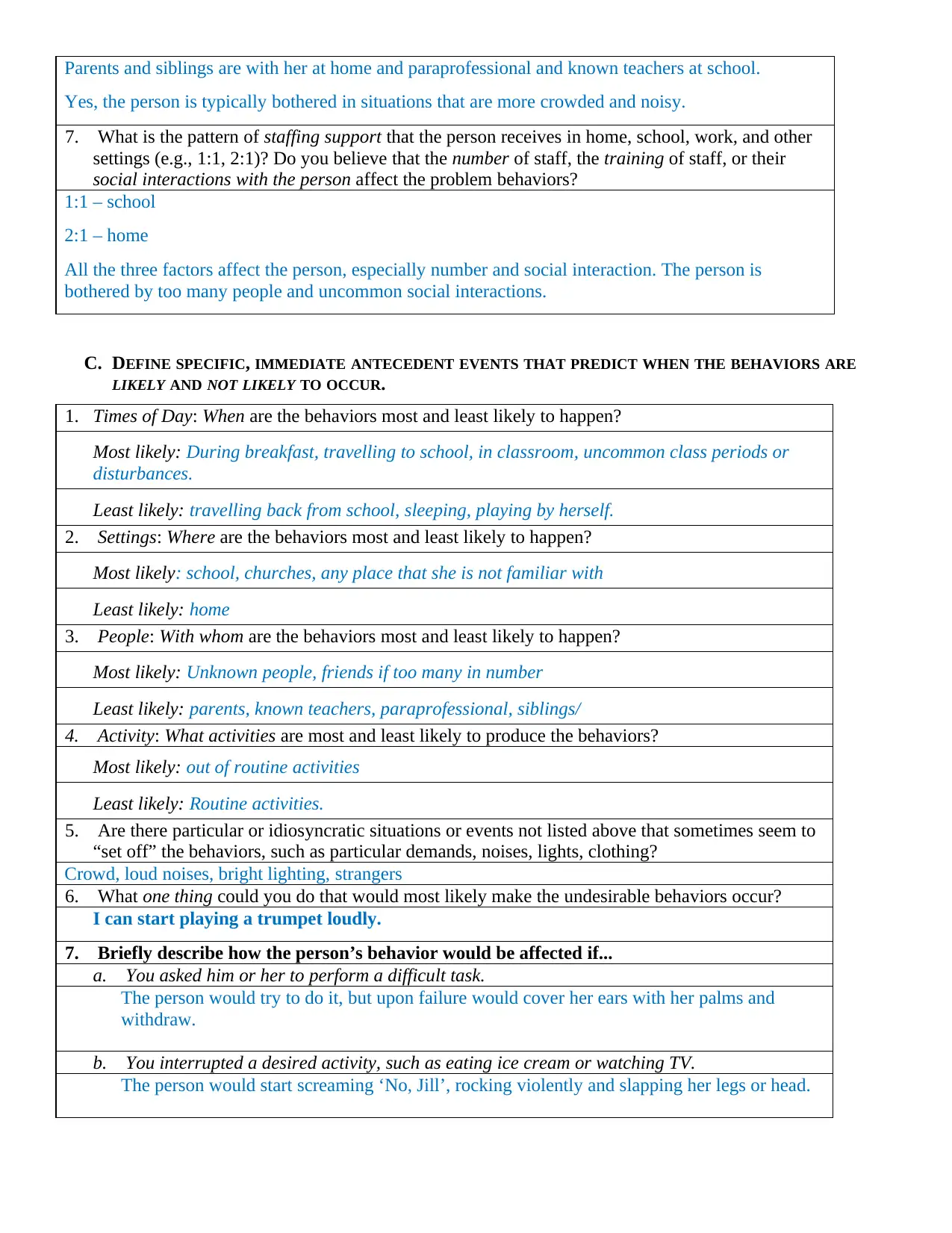
Parents and siblings are with her at home and paraprofessional and known teachers at school.
Yes, the person is typically bothered in situations that are more crowded and noisy.
7. What is the pattern of staffing support that the person receives in home, school, work, and other
settings (e.g., 1:1, 2:1)? Do you believe that the number of staff, the training of staff, or their
social interactions with the person affect the problem behaviors?
1:1 – school
2:1 – home
All the three factors affect the person, especially number and social interaction. The person is
bothered by too many people and uncommon social interactions.
C. DEFINE SPECIFIC, IMMEDIATE ANTECEDENT EVENTS THAT PREDICT WHEN THE BEHAVIORS ARE
LIKELY AND NOT LIKELY TO OCCUR.
1. Times of Day: When are the behaviors most and least likely to happen?
Most likely: During breakfast, travelling to school, in classroom, uncommon class periods or
disturbances.
Least likely: travelling back from school, sleeping, playing by herself.
2. Settings: Where are the behaviors most and least likely to happen?
Most likely: school, churches, any place that she is not familiar with
Least likely: home
3. People: With whom are the behaviors most and least likely to happen?
Most likely: Unknown people, friends if too many in number
Least likely: parents, known teachers, paraprofessional, siblings/
4. Activity: What activities are most and least likely to produce the behaviors?
Most likely: out of routine activities
Least likely: Routine activities.
5. Are there particular or idiosyncratic situations or events not listed above that sometimes seem to
“set off” the behaviors, such as particular demands, noises, lights, clothing?
Crowd, loud noises, bright lighting, strangers
6. What one thing could you do that would most likely make the undesirable behaviors occur?
I can start playing a trumpet loudly.
7. Briefly describe how the person’s behavior would be affected if...
a. You asked him or her to perform a difficult task.
The person would try to do it, but upon failure would cover her ears with her palms and
withdraw.
b. You interrupted a desired activity, such as eating ice cream or watching TV.
The person would start screaming ‘No, Jill’, rocking violently and slapping her legs or head.
Yes, the person is typically bothered in situations that are more crowded and noisy.
7. What is the pattern of staffing support that the person receives in home, school, work, and other
settings (e.g., 1:1, 2:1)? Do you believe that the number of staff, the training of staff, or their
social interactions with the person affect the problem behaviors?
1:1 – school
2:1 – home
All the three factors affect the person, especially number and social interaction. The person is
bothered by too many people and uncommon social interactions.
C. DEFINE SPECIFIC, IMMEDIATE ANTECEDENT EVENTS THAT PREDICT WHEN THE BEHAVIORS ARE
LIKELY AND NOT LIKELY TO OCCUR.
1. Times of Day: When are the behaviors most and least likely to happen?
Most likely: During breakfast, travelling to school, in classroom, uncommon class periods or
disturbances.
Least likely: travelling back from school, sleeping, playing by herself.
2. Settings: Where are the behaviors most and least likely to happen?
Most likely: school, churches, any place that she is not familiar with
Least likely: home
3. People: With whom are the behaviors most and least likely to happen?
Most likely: Unknown people, friends if too many in number
Least likely: parents, known teachers, paraprofessional, siblings/
4. Activity: What activities are most and least likely to produce the behaviors?
Most likely: out of routine activities
Least likely: Routine activities.
5. Are there particular or idiosyncratic situations or events not listed above that sometimes seem to
“set off” the behaviors, such as particular demands, noises, lights, clothing?
Crowd, loud noises, bright lighting, strangers
6. What one thing could you do that would most likely make the undesirable behaviors occur?
I can start playing a trumpet loudly.
7. Briefly describe how the person’s behavior would be affected if...
a. You asked him or her to perform a difficult task.
The person would try to do it, but upon failure would cover her ears with her palms and
withdraw.
b. You interrupted a desired activity, such as eating ice cream or watching TV.
The person would start screaming ‘No, Jill’, rocking violently and slapping her legs or head.
Secure Best Marks with AI Grader
Need help grading? Try our AI Grader for instant feedback on your assignments.
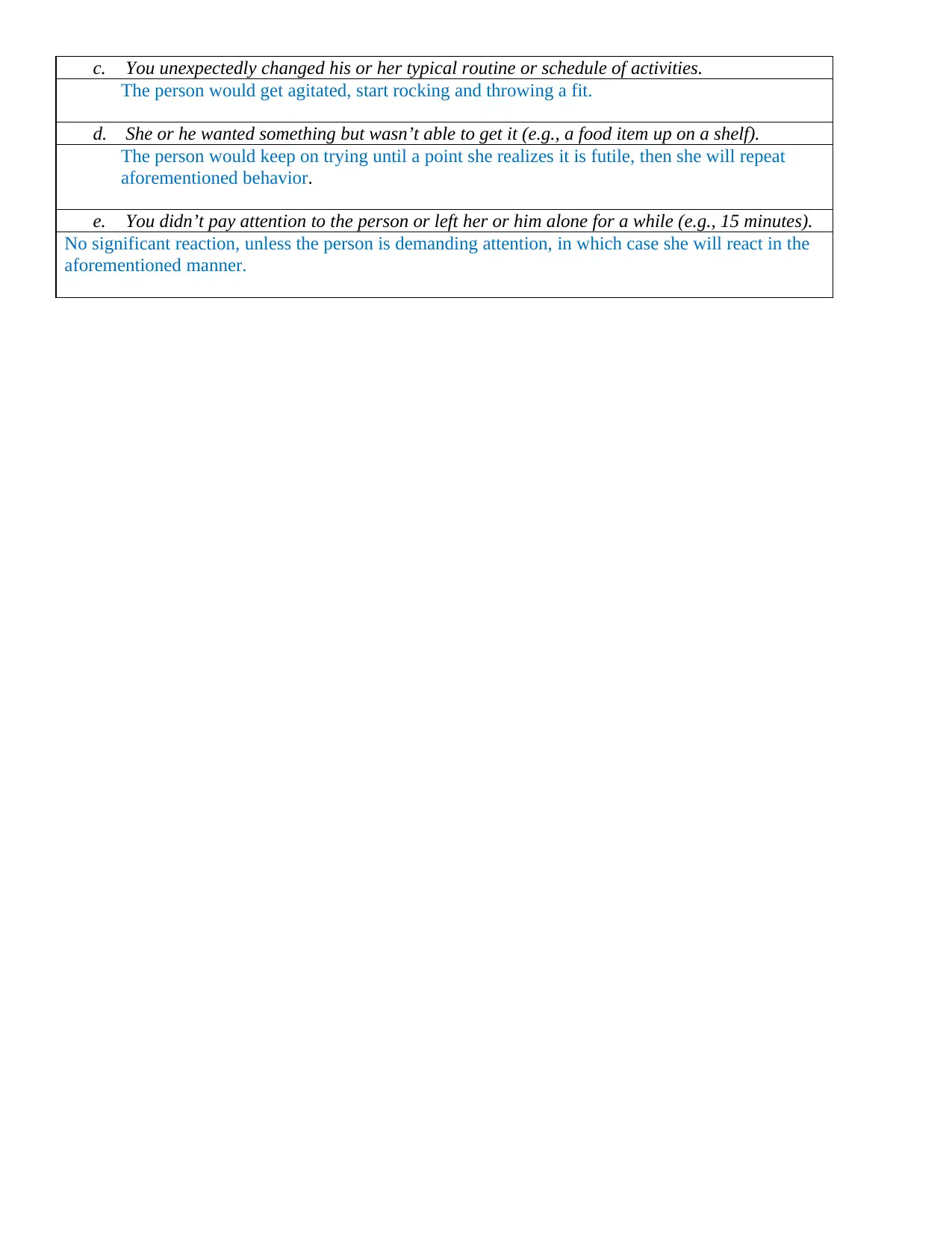
c. You unexpectedly changed his or her typical routine or schedule of activities.
The person would get agitated, start rocking and throwing a fit.
d. She or he wanted something but wasn’t able to get it (e.g., a food item up on a shelf).
The person would keep on trying until a point she realizes it is futile, then she will repeat
aforementioned behavior.
e. You didn’t pay attention to the person or left her or him alone for a while (e.g., 15 minutes).
No significant reaction, unless the person is demanding attention, in which case she will react in the
aforementioned manner.
The person would get agitated, start rocking and throwing a fit.
d. She or he wanted something but wasn’t able to get it (e.g., a food item up on a shelf).
The person would keep on trying until a point she realizes it is futile, then she will repeat
aforementioned behavior.
e. You didn’t pay attention to the person or left her or him alone for a while (e.g., 15 minutes).
No significant reaction, unless the person is demanding attention, in which case she will react in the
aforementioned manner.
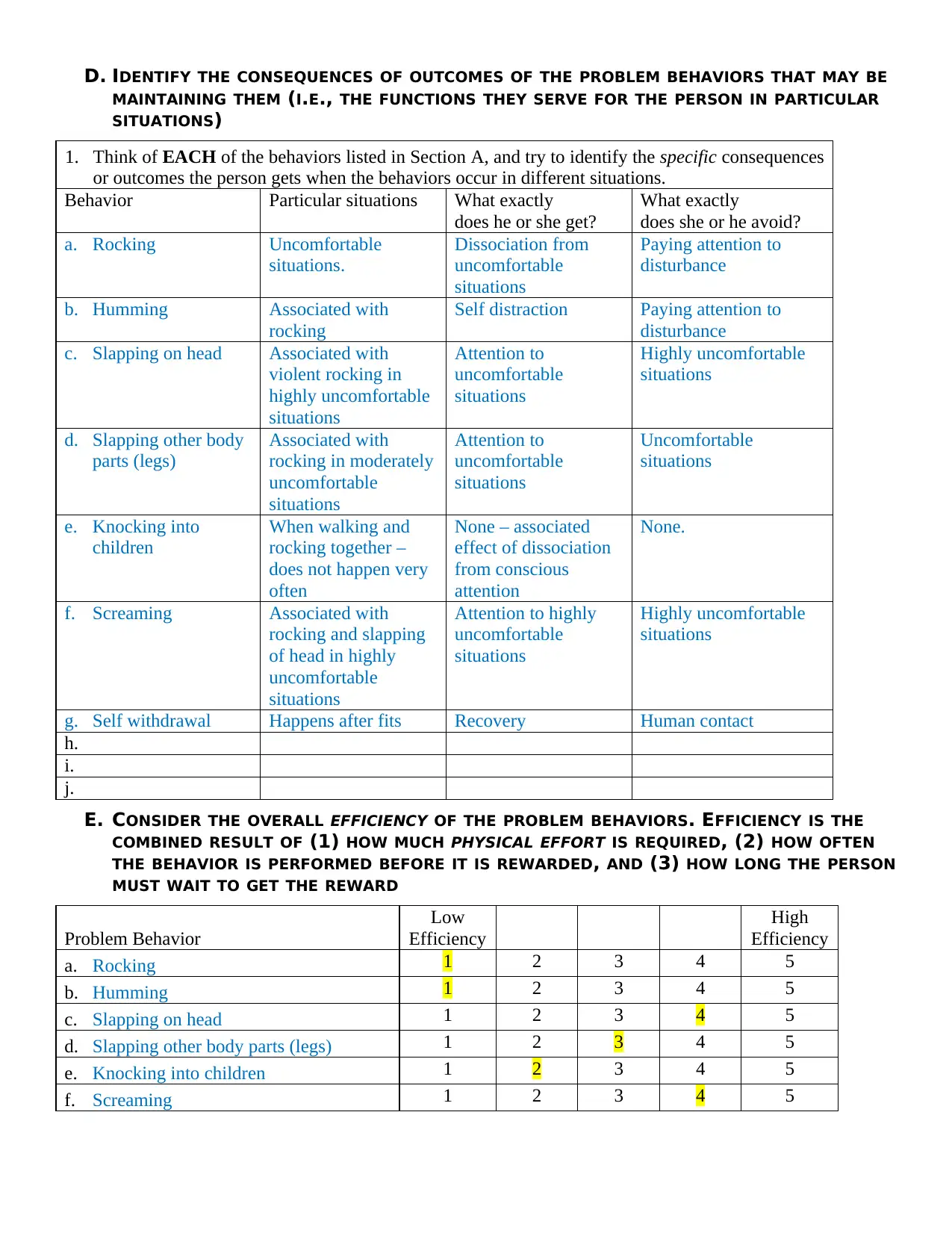
D. IDENTIFY THE CONSEQUENCES OF OUTCOMES OF THE PROBLEM BEHAVIORS THAT MAY BE
MAINTAINING THEM (I.E., THE FUNCTIONS THEY SERVE FOR THE PERSON IN PARTICULAR
SITUATIONS)
1. Think of EACH of the behaviors listed in Section A, and try to identify the specific consequences
or outcomes the person gets when the behaviors occur in different situations.
Behavior Particular situations What exactly
does he or she get?
What exactly
does she or he avoid?
a. Rocking Uncomfortable
situations.
Dissociation from
uncomfortable
situations
Paying attention to
disturbance
b. Humming Associated with
rocking
Self distraction Paying attention to
disturbance
c. Slapping on head Associated with
violent rocking in
highly uncomfortable
situations
Attention to
uncomfortable
situations
Highly uncomfortable
situations
d. Slapping other body
parts (legs)
Associated with
rocking in moderately
uncomfortable
situations
Attention to
uncomfortable
situations
Uncomfortable
situations
e. Knocking into
children
When walking and
rocking together –
does not happen very
often
None – associated
effect of dissociation
from conscious
attention
None.
f. Screaming Associated with
rocking and slapping
of head in highly
uncomfortable
situations
Attention to highly
uncomfortable
situations
Highly uncomfortable
situations
g. Self withdrawal Happens after fits Recovery Human contact
h.
i.
j.
E. CONSIDER THE OVERALL EFFICIENCY OF THE PROBLEM BEHAVIORS. EFFICIENCY IS THE
COMBINED RESULT OF (1) HOW MUCH PHYSICAL EFFORT IS REQUIRED, (2) HOW OFTEN
THE BEHAVIOR IS PERFORMED BEFORE IT IS REWARDED, AND (3) HOW LONG THE PERSON
MUST WAIT TO GET THE REWARD
Problem Behavior
Low
Efficiency
High
Efficiency
a. Rocking 1 2 3 4 5
b. Humming 1 2 3 4 5
c. Slapping on head 1 2 3 4 5
d. Slapping other body parts (legs) 1 2 3 4 5
e. Knocking into children 1 2 3 4 5
f. Screaming 1 2 3 4 5
MAINTAINING THEM (I.E., THE FUNCTIONS THEY SERVE FOR THE PERSON IN PARTICULAR
SITUATIONS)
1. Think of EACH of the behaviors listed in Section A, and try to identify the specific consequences
or outcomes the person gets when the behaviors occur in different situations.
Behavior Particular situations What exactly
does he or she get?
What exactly
does she or he avoid?
a. Rocking Uncomfortable
situations.
Dissociation from
uncomfortable
situations
Paying attention to
disturbance
b. Humming Associated with
rocking
Self distraction Paying attention to
disturbance
c. Slapping on head Associated with
violent rocking in
highly uncomfortable
situations
Attention to
uncomfortable
situations
Highly uncomfortable
situations
d. Slapping other body
parts (legs)
Associated with
rocking in moderately
uncomfortable
situations
Attention to
uncomfortable
situations
Uncomfortable
situations
e. Knocking into
children
When walking and
rocking together –
does not happen very
often
None – associated
effect of dissociation
from conscious
attention
None.
f. Screaming Associated with
rocking and slapping
of head in highly
uncomfortable
situations
Attention to highly
uncomfortable
situations
Highly uncomfortable
situations
g. Self withdrawal Happens after fits Recovery Human contact
h.
i.
j.
E. CONSIDER THE OVERALL EFFICIENCY OF THE PROBLEM BEHAVIORS. EFFICIENCY IS THE
COMBINED RESULT OF (1) HOW MUCH PHYSICAL EFFORT IS REQUIRED, (2) HOW OFTEN
THE BEHAVIOR IS PERFORMED BEFORE IT IS REWARDED, AND (3) HOW LONG THE PERSON
MUST WAIT TO GET THE REWARD
Problem Behavior
Low
Efficiency
High
Efficiency
a. Rocking 1 2 3 4 5
b. Humming 1 2 3 4 5
c. Slapping on head 1 2 3 4 5
d. Slapping other body parts (legs) 1 2 3 4 5
e. Knocking into children 1 2 3 4 5
f. Screaming 1 2 3 4 5
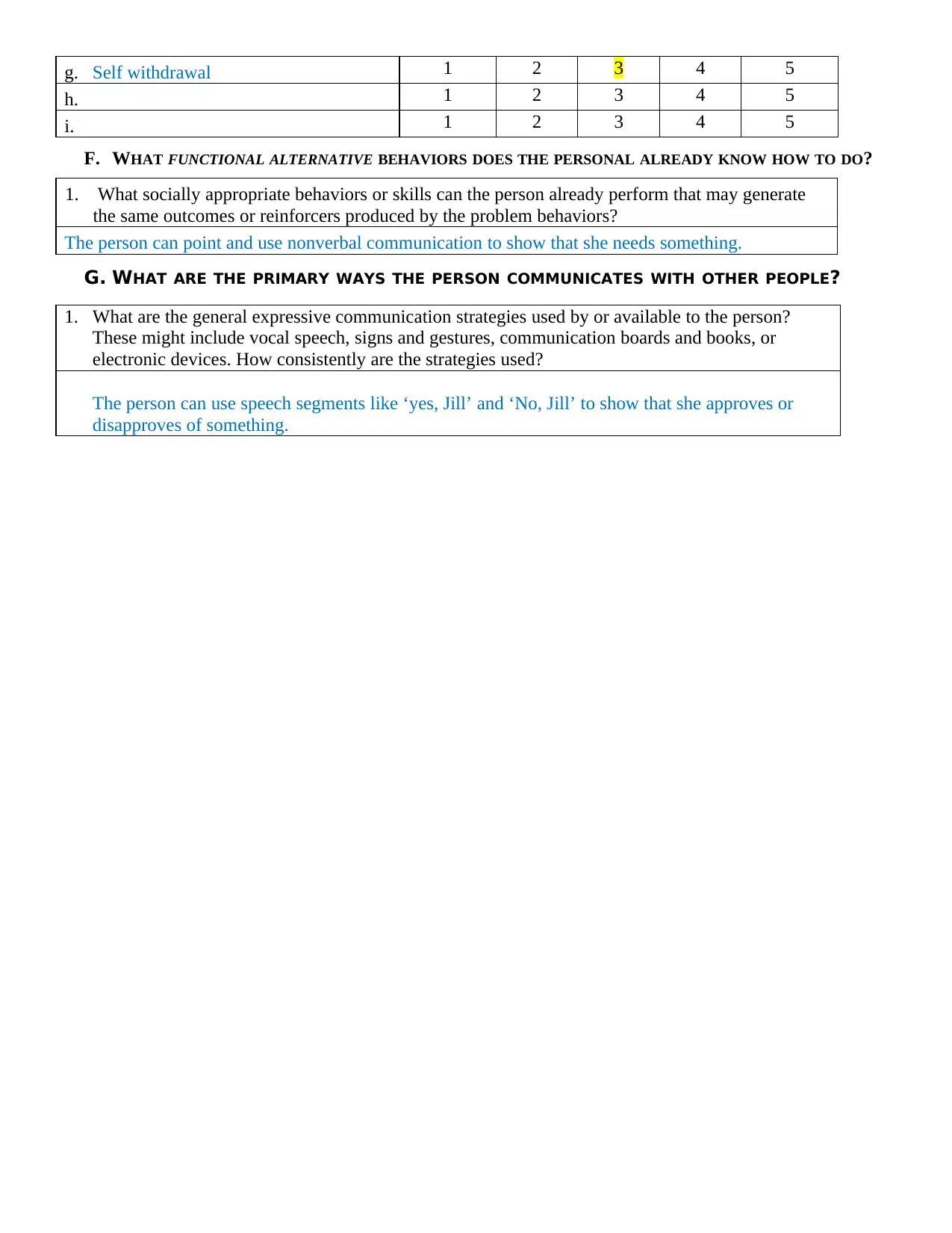
g. Self withdrawal 1 2 3 4 5
h. 1 2 3 4 5
i. 1 2 3 4 5
F. WHAT FUNCTIONAL ALTERNATIVE BEHAVIORS DOES THE PERSONAL ALREADY KNOW HOW TO DO?
1. What socially appropriate behaviors or skills can the person already perform that may generate
the same outcomes or reinforcers produced by the problem behaviors?
The person can point and use nonverbal communication to show that she needs something.
G. WHAT ARE THE PRIMARY WAYS THE PERSON COMMUNICATES WITH OTHER PEOPLE?
1. What are the general expressive communication strategies used by or available to the person?
These might include vocal speech, signs and gestures, communication boards and books, or
electronic devices. How consistently are the strategies used?
The person can use speech segments like ‘yes, Jill’ and ‘No, Jill’ to show that she approves or
disapproves of something.
h. 1 2 3 4 5
i. 1 2 3 4 5
F. WHAT FUNCTIONAL ALTERNATIVE BEHAVIORS DOES THE PERSONAL ALREADY KNOW HOW TO DO?
1. What socially appropriate behaviors or skills can the person already perform that may generate
the same outcomes or reinforcers produced by the problem behaviors?
The person can point and use nonverbal communication to show that she needs something.
G. WHAT ARE THE PRIMARY WAYS THE PERSON COMMUNICATES WITH OTHER PEOPLE?
1. What are the general expressive communication strategies used by or available to the person?
These might include vocal speech, signs and gestures, communication boards and books, or
electronic devices. How consistently are the strategies used?
The person can use speech segments like ‘yes, Jill’ and ‘No, Jill’ to show that she approves or
disapproves of something.
Paraphrase This Document
Need a fresh take? Get an instant paraphrase of this document with our AI Paraphraser
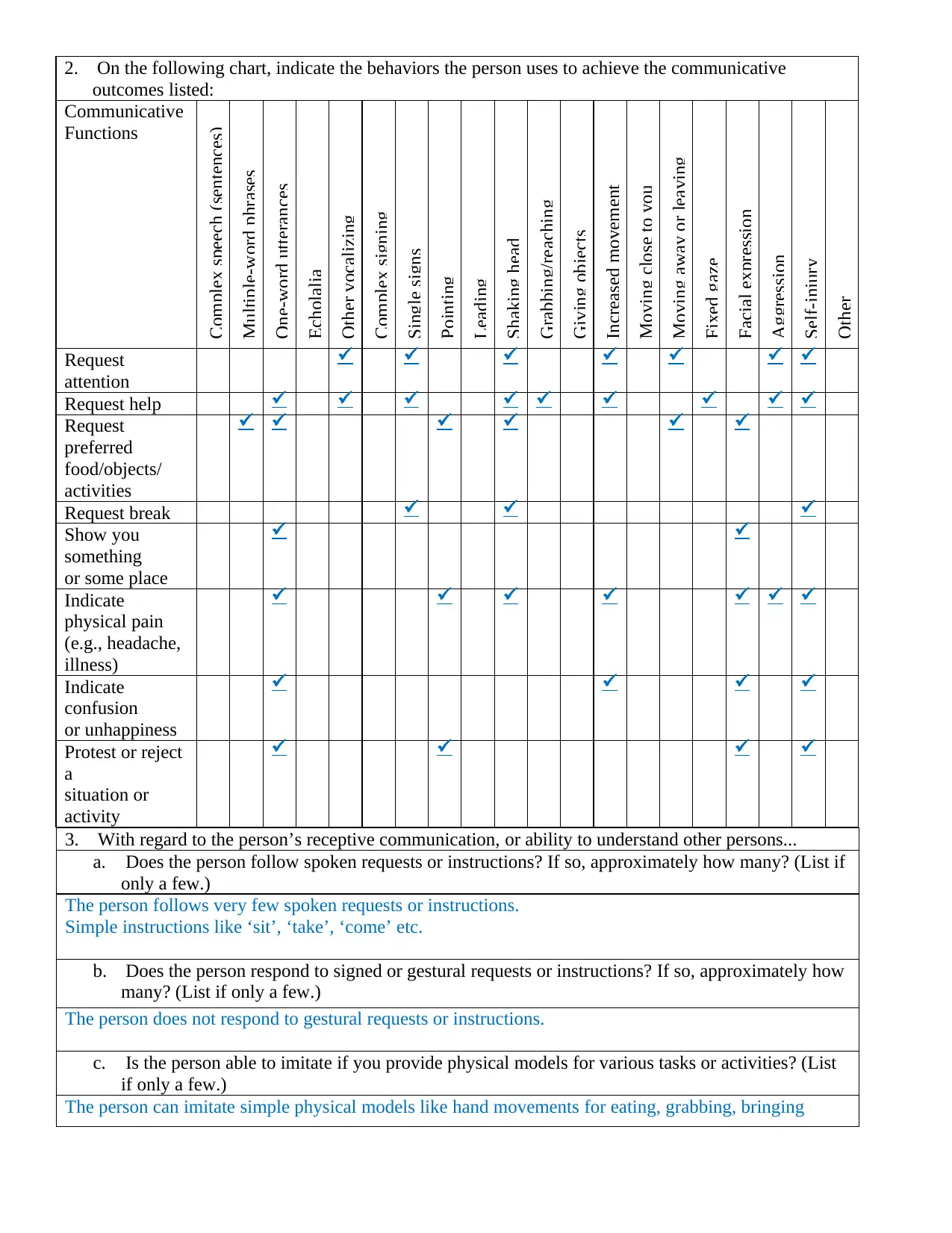
2. On the following chart, indicate the behaviors the person uses to achieve the communicative
outcomes listed:
Communicative
Functions
Complex speech (sentences)
Multiple-word phrases
One-word utterances
Echolalia
Other vocalizing
Complex signing
Single signs
Pointing
Leading
Shaking head
Grabbing/reaching
Giving objects
Increased movement
Moving close to you
Moving away or leaving
Fixed gaze
Facial expression
Aggression
Self-injury
Other
Request
attention
Request help
Request
preferred
food/objects/
activities
Request break
Show you
something
or some place
Indicate
physical pain
(e.g., headache,
illness)
Indicate
confusion
or unhappiness
Protest or reject
a
situation or
activity
3. With regard to the person’s receptive communication, or ability to understand other persons...
a. Does the person follow spoken requests or instructions? If so, approximately how many? (List if
only a few.)
The person follows very few spoken requests or instructions.
Simple instructions like ‘sit’, ‘take’, ‘come’ etc.
b. Does the person respond to signed or gestural requests or instructions? If so, approximately how
many? (List if only a few.)
The person does not respond to gestural requests or instructions.
c. Is the person able to imitate if you provide physical models for various tasks or activities? (List
if only a few.)
The person can imitate simple physical models like hand movements for eating, grabbing, bringing
outcomes listed:
Communicative
Functions
Complex speech (sentences)
Multiple-word phrases
One-word utterances
Echolalia
Other vocalizing
Complex signing
Single signs
Pointing
Leading
Shaking head
Grabbing/reaching
Giving objects
Increased movement
Moving close to you
Moving away or leaving
Fixed gaze
Facial expression
Aggression
Self-injury
Other
Request
attention
Request help
Request
preferred
food/objects/
activities
Request break
Show you
something
or some place
Indicate
physical pain
(e.g., headache,
illness)
Indicate
confusion
or unhappiness
Protest or reject
a
situation or
activity
3. With regard to the person’s receptive communication, or ability to understand other persons...
a. Does the person follow spoken requests or instructions? If so, approximately how many? (List if
only a few.)
The person follows very few spoken requests or instructions.
Simple instructions like ‘sit’, ‘take’, ‘come’ etc.
b. Does the person respond to signed or gestural requests or instructions? If so, approximately how
many? (List if only a few.)
The person does not respond to gestural requests or instructions.
c. Is the person able to imitate if you provide physical models for various tasks or activities? (List
if only a few.)
The person can imitate simple physical models like hand movements for eating, grabbing, bringing
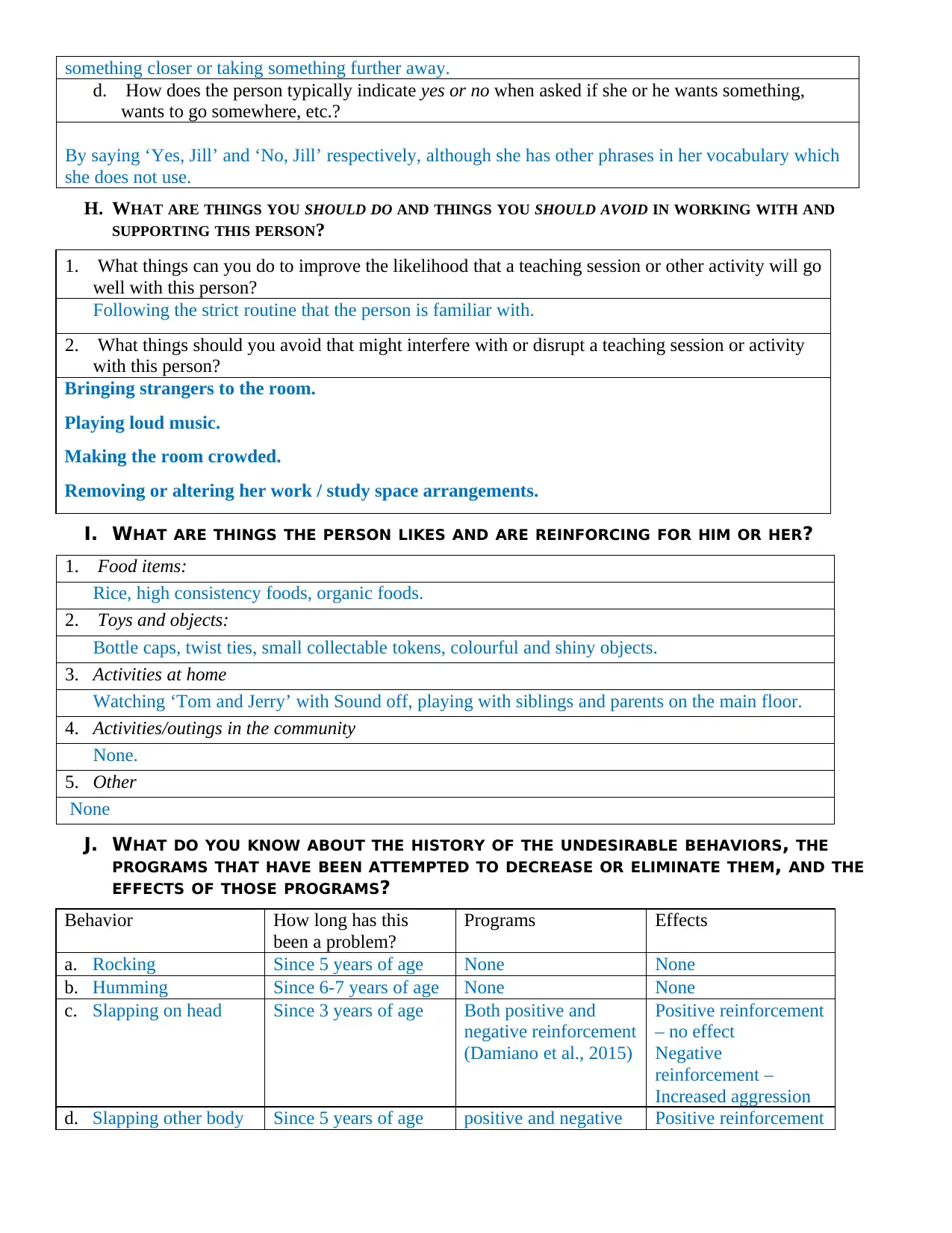
something closer or taking something further away.
d. How does the person typically indicate yes or no when asked if she or he wants something,
wants to go somewhere, etc.?
By saying ‘Yes, Jill’ and ‘No, Jill’ respectively, although she has other phrases in her vocabulary which
she does not use.
H. WHAT ARE THINGS YOU SHOULD DO AND THINGS YOU SHOULD AVOID IN WORKING WITH AND
SUPPORTING THIS PERSON?
1. What things can you do to improve the likelihood that a teaching session or other activity will go
well with this person?
Following the strict routine that the person is familiar with.
2. What things should you avoid that might interfere with or disrupt a teaching session or activity
with this person?
Bringing strangers to the room.
Playing loud music.
Making the room crowded.
Removing or altering her work / study space arrangements.
I. WHAT ARE THINGS THE PERSON LIKES AND ARE REINFORCING FOR HIM OR HER?
1. Food items:
Rice, high consistency foods, organic foods.
2. Toys and objects:
Bottle caps, twist ties, small collectable tokens, colourful and shiny objects.
3. Activities at home
Watching ‘Tom and Jerry’ with Sound off, playing with siblings and parents on the main floor.
4. Activities/outings in the community
None.
5. Other
None
J. WHAT DO YOU KNOW ABOUT THE HISTORY OF THE UNDESIRABLE BEHAVIORS, THE
PROGRAMS THAT HAVE BEEN ATTEMPTED TO DECREASE OR ELIMINATE THEM, AND THE
EFFECTS OF THOSE PROGRAMS?
Behavior How long has this
been a problem?
Programs Effects
a. Rocking Since 5 years of age None None
b. Humming Since 6-7 years of age None None
c. Slapping on head Since 3 years of age Both positive and
negative reinforcement
(Damiano et al., 2015)
Positive reinforcement
– no effect
Negative
reinforcement –
Increased aggression
d. Slapping other body Since 5 years of age positive and negative Positive reinforcement
d. How does the person typically indicate yes or no when asked if she or he wants something,
wants to go somewhere, etc.?
By saying ‘Yes, Jill’ and ‘No, Jill’ respectively, although she has other phrases in her vocabulary which
she does not use.
H. WHAT ARE THINGS YOU SHOULD DO AND THINGS YOU SHOULD AVOID IN WORKING WITH AND
SUPPORTING THIS PERSON?
1. What things can you do to improve the likelihood that a teaching session or other activity will go
well with this person?
Following the strict routine that the person is familiar with.
2. What things should you avoid that might interfere with or disrupt a teaching session or activity
with this person?
Bringing strangers to the room.
Playing loud music.
Making the room crowded.
Removing or altering her work / study space arrangements.
I. WHAT ARE THINGS THE PERSON LIKES AND ARE REINFORCING FOR HIM OR HER?
1. Food items:
Rice, high consistency foods, organic foods.
2. Toys and objects:
Bottle caps, twist ties, small collectable tokens, colourful and shiny objects.
3. Activities at home
Watching ‘Tom and Jerry’ with Sound off, playing with siblings and parents on the main floor.
4. Activities/outings in the community
None.
5. Other
None
J. WHAT DO YOU KNOW ABOUT THE HISTORY OF THE UNDESIRABLE BEHAVIORS, THE
PROGRAMS THAT HAVE BEEN ATTEMPTED TO DECREASE OR ELIMINATE THEM, AND THE
EFFECTS OF THOSE PROGRAMS?
Behavior How long has this
been a problem?
Programs Effects
a. Rocking Since 5 years of age None None
b. Humming Since 6-7 years of age None None
c. Slapping on head Since 3 years of age Both positive and
negative reinforcement
(Damiano et al., 2015)
Positive reinforcement
– no effect
Negative
reinforcement –
Increased aggression
d. Slapping other body Since 5 years of age positive and negative Positive reinforcement
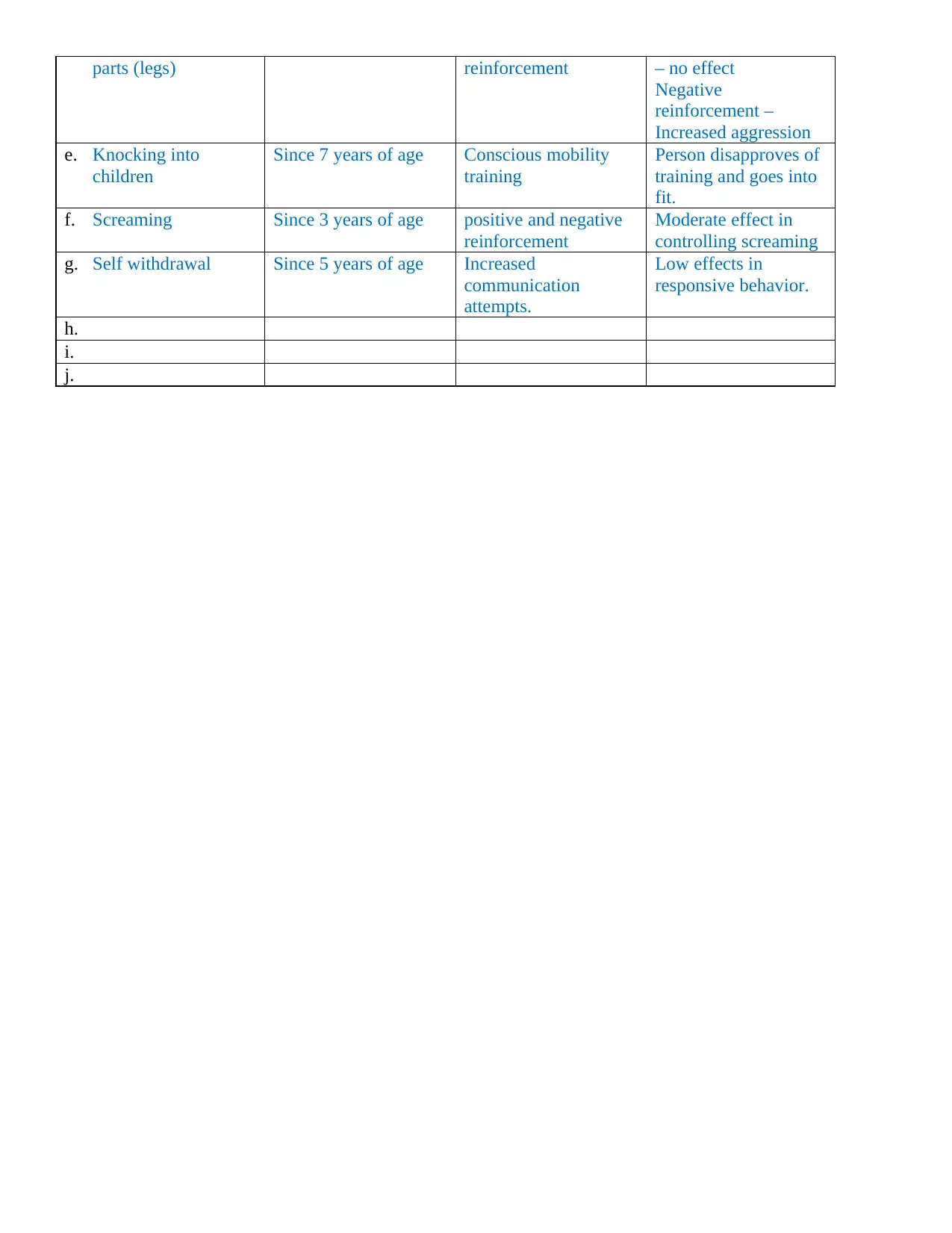
parts (legs) reinforcement – no effect
Negative
reinforcement –
Increased aggression
e. Knocking into
children
Since 7 years of age Conscious mobility
training
Person disapproves of
training and goes into
fit.
f. Screaming Since 3 years of age positive and negative
reinforcement
Moderate effect in
controlling screaming
g. Self withdrawal Since 5 years of age Increased
communication
attempts.
Low effects in
responsive behavior.
h.
i.
j.
Negative
reinforcement –
Increased aggression
e. Knocking into
children
Since 7 years of age Conscious mobility
training
Person disapproves of
training and goes into
fit.
f. Screaming Since 3 years of age positive and negative
reinforcement
Moderate effect in
controlling screaming
g. Self withdrawal Since 5 years of age Increased
communication
attempts.
Low effects in
responsive behavior.
h.
i.
j.
Secure Best Marks with AI Grader
Need help grading? Try our AI Grader for instant feedback on your assignments.
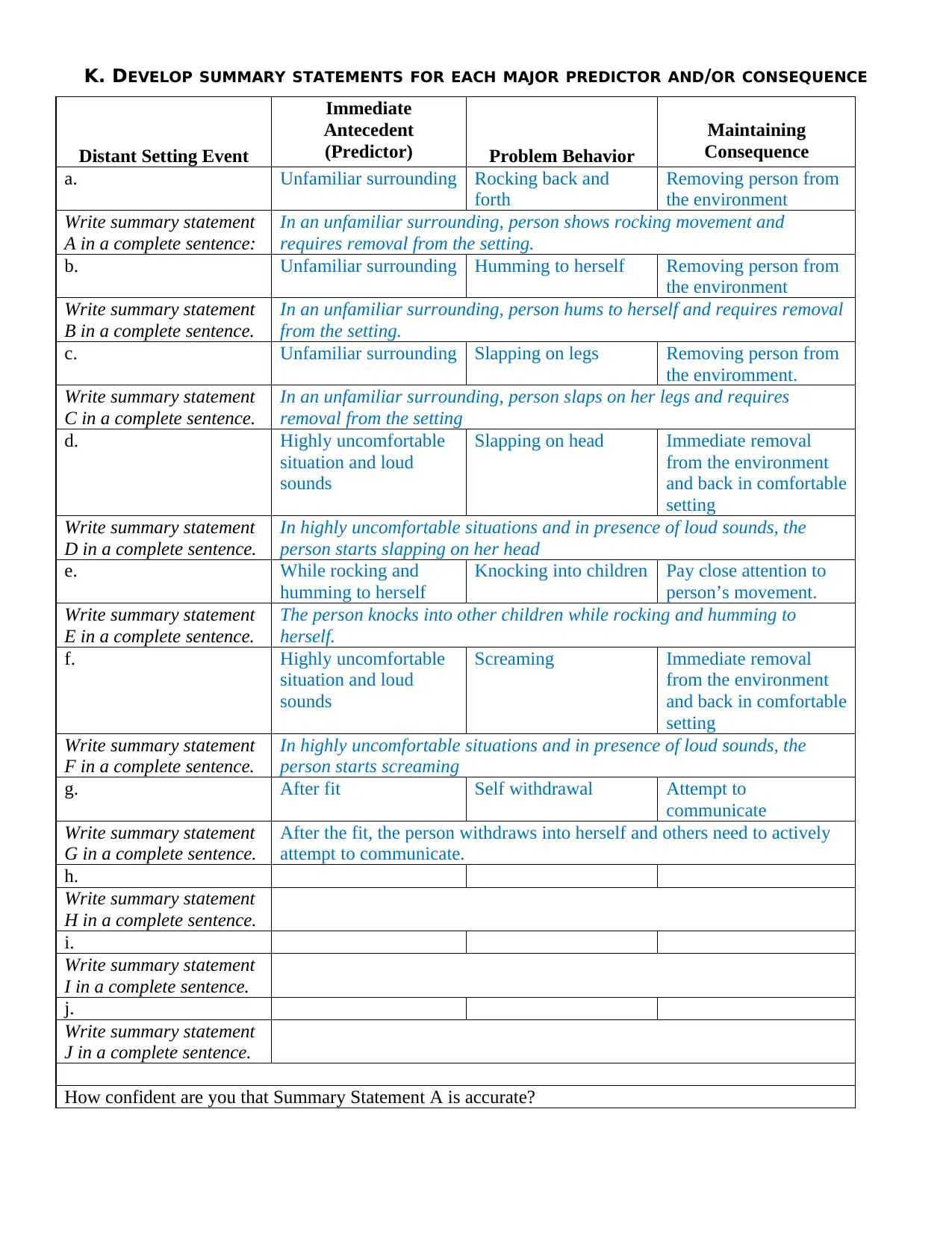
K. DEVELOP SUMMARY STATEMENTS FOR EACH MAJOR PREDICTOR AND/OR CONSEQUENCE
Distant Setting Event
Immediate
Antecedent
(Predictor) Problem Behavior
Maintaining
Consequence
a. Unfamiliar surrounding Rocking back and
forth
Removing person from
the environment
Write summary statement
A in a complete sentence:
In an unfamiliar surrounding, person shows rocking movement and
requires removal from the setting.
b. Unfamiliar surrounding Humming to herself Removing person from
the environment
Write summary statement
B in a complete sentence.
In an unfamiliar surrounding, person hums to herself and requires removal
from the setting.
c. Unfamiliar surrounding Slapping on legs Removing person from
the enviromment.
Write summary statement
C in a complete sentence.
In an unfamiliar surrounding, person slaps on her legs and requires
removal from the setting
d. Highly uncomfortable
situation and loud
sounds
Slapping on head Immediate removal
from the environment
and back in comfortable
setting
Write summary statement
D in a complete sentence.
In highly uncomfortable situations and in presence of loud sounds, the
person starts slapping on her head
e. While rocking and
humming to herself
Knocking into children Pay close attention to
person’s movement.
Write summary statement
E in a complete sentence.
The person knocks into other children while rocking and humming to
herself.
f. Highly uncomfortable
situation and loud
sounds
Screaming Immediate removal
from the environment
and back in comfortable
setting
Write summary statement
F in a complete sentence.
In highly uncomfortable situations and in presence of loud sounds, the
person starts screaming
g. After fit Self withdrawal Attempt to
communicate
Write summary statement
G in a complete sentence.
After the fit, the person withdraws into herself and others need to actively
attempt to communicate.
h.
Write summary statement
H in a complete sentence.
i.
Write summary statement
I in a complete sentence.
j.
Write summary statement
J in a complete sentence.
How confident are you that Summary Statement A is accurate?
Distant Setting Event
Immediate
Antecedent
(Predictor) Problem Behavior
Maintaining
Consequence
a. Unfamiliar surrounding Rocking back and
forth
Removing person from
the environment
Write summary statement
A in a complete sentence:
In an unfamiliar surrounding, person shows rocking movement and
requires removal from the setting.
b. Unfamiliar surrounding Humming to herself Removing person from
the environment
Write summary statement
B in a complete sentence.
In an unfamiliar surrounding, person hums to herself and requires removal
from the setting.
c. Unfamiliar surrounding Slapping on legs Removing person from
the enviromment.
Write summary statement
C in a complete sentence.
In an unfamiliar surrounding, person slaps on her legs and requires
removal from the setting
d. Highly uncomfortable
situation and loud
sounds
Slapping on head Immediate removal
from the environment
and back in comfortable
setting
Write summary statement
D in a complete sentence.
In highly uncomfortable situations and in presence of loud sounds, the
person starts slapping on her head
e. While rocking and
humming to herself
Knocking into children Pay close attention to
person’s movement.
Write summary statement
E in a complete sentence.
The person knocks into other children while rocking and humming to
herself.
f. Highly uncomfortable
situation and loud
sounds
Screaming Immediate removal
from the environment
and back in comfortable
setting
Write summary statement
F in a complete sentence.
In highly uncomfortable situations and in presence of loud sounds, the
person starts screaming
g. After fit Self withdrawal Attempt to
communicate
Write summary statement
G in a complete sentence.
After the fit, the person withdraws into herself and others need to actively
attempt to communicate.
h.
Write summary statement
H in a complete sentence.
i.
Write summary statement
I in a complete sentence.
j.
Write summary statement
J in a complete sentence.
How confident are you that Summary Statement A is accurate?
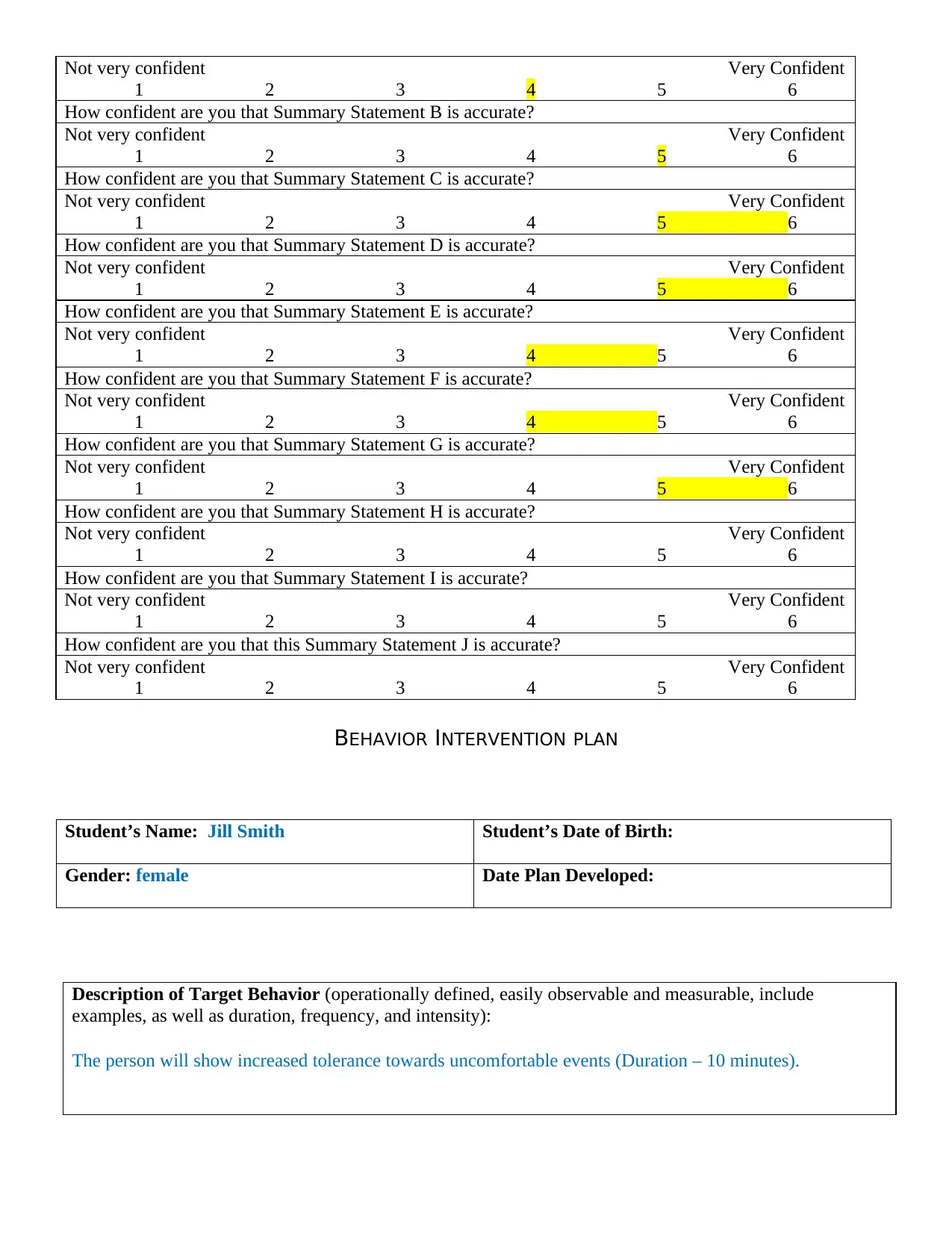
Not very confident Very Confident
1 2 3 4 5 6
How confident are you that Summary Statement B is accurate?
Not very confident Very Confident
1 2 3 4 5 6
How confident are you that Summary Statement C is accurate?
Not very confident Very Confident
1 2 3 4 5 6
How confident are you that Summary Statement D is accurate?
Not very confident Very Confident
1 2 3 4 5 6
How confident are you that Summary Statement E is accurate?
Not very confident Very Confident
1 2 3 4 5 6
How confident are you that Summary Statement F is accurate?
Not very confident Very Confident
1 2 3 4 5 6
How confident are you that Summary Statement G is accurate?
Not very confident Very Confident
1 2 3 4 5 6
How confident are you that Summary Statement H is accurate?
Not very confident Very Confident
1 2 3 4 5 6
How confident are you that Summary Statement I is accurate?
Not very confident Very Confident
1 2 3 4 5 6
How confident are you that this Summary Statement J is accurate?
Not very confident Very Confident
1 2 3 4 5 6
BEHAVIOR INTERVENTION PLAN
Student’s Name: Jill Smith Student’s Date of Birth:
Gender: female Date Plan Developed:
Description of Target Behavior (operationally defined, easily observable and measurable, include
examples, as well as duration, frequency, and intensity):
The person will show increased tolerance towards uncomfortable events (Duration – 10 minutes).
1 2 3 4 5 6
How confident are you that Summary Statement B is accurate?
Not very confident Very Confident
1 2 3 4 5 6
How confident are you that Summary Statement C is accurate?
Not very confident Very Confident
1 2 3 4 5 6
How confident are you that Summary Statement D is accurate?
Not very confident Very Confident
1 2 3 4 5 6
How confident are you that Summary Statement E is accurate?
Not very confident Very Confident
1 2 3 4 5 6
How confident are you that Summary Statement F is accurate?
Not very confident Very Confident
1 2 3 4 5 6
How confident are you that Summary Statement G is accurate?
Not very confident Very Confident
1 2 3 4 5 6
How confident are you that Summary Statement H is accurate?
Not very confident Very Confident
1 2 3 4 5 6
How confident are you that Summary Statement I is accurate?
Not very confident Very Confident
1 2 3 4 5 6
How confident are you that this Summary Statement J is accurate?
Not very confident Very Confident
1 2 3 4 5 6
BEHAVIOR INTERVENTION PLAN
Student’s Name: Jill Smith Student’s Date of Birth:
Gender: female Date Plan Developed:
Description of Target Behavior (operationally defined, easily observable and measurable, include
examples, as well as duration, frequency, and intensity):
The person will show increased tolerance towards uncomfortable events (Duration – 10 minutes).
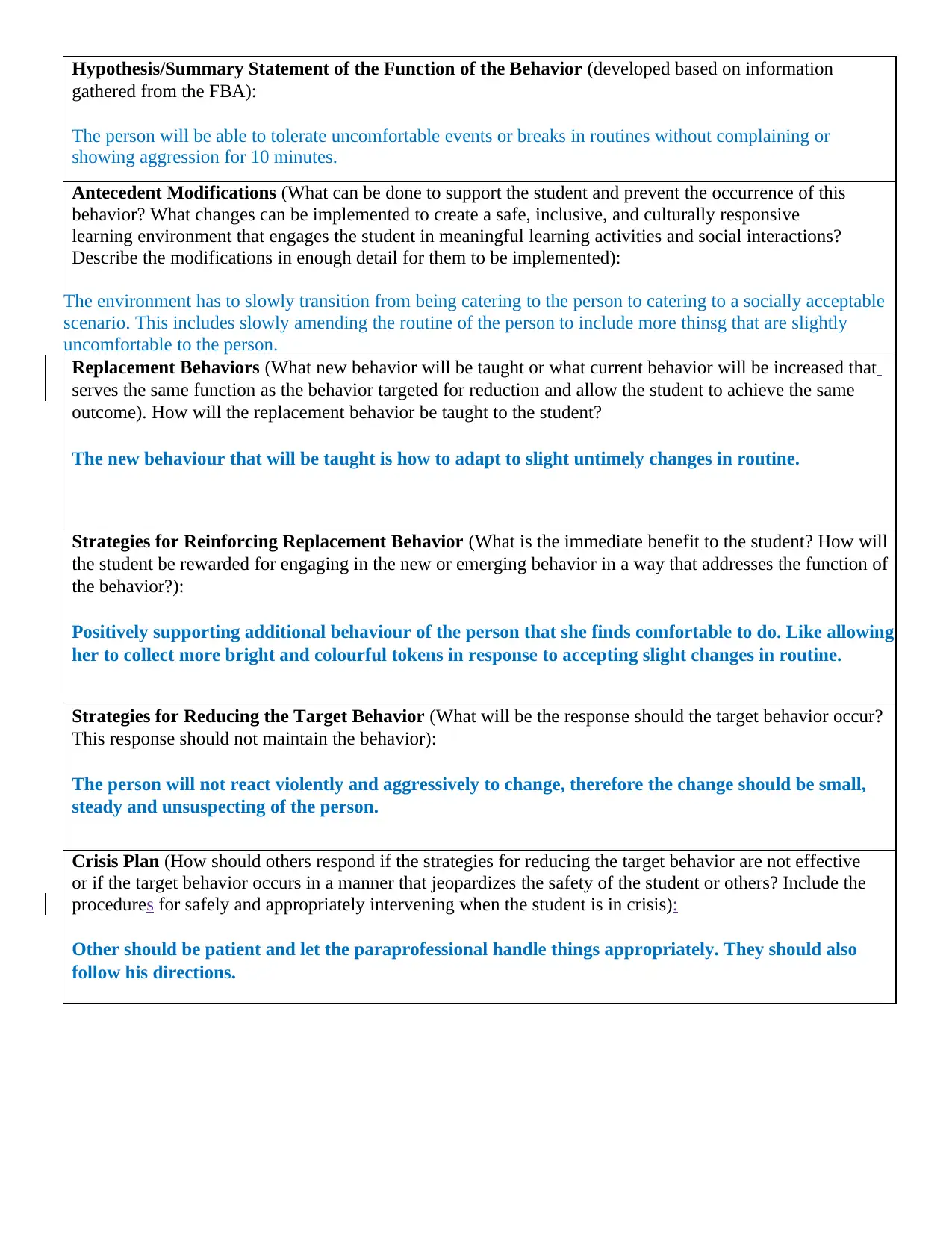
Hypothesis/Summary Statement of the Function of the Behavior (developed based on information
gathered from the FBA):
The person will be able to tolerate uncomfortable events or breaks in routines without complaining or
showing aggression for 10 minutes.
Antecedent Modifications (What can be done to support the student and prevent the occurrence of this
behavior? What changes can be implemented to create a safe, inclusive, and culturally responsive
learning environment that engages the student in meaningful learning activities and social interactions?
Describe the modifications in enough detail for them to be implemented):
The environment has to slowly transition from being catering to the person to catering to a socially acceptable
scenario. This includes slowly amending the routine of the person to include more thinsg that are slightly
uncomfortable to the person.
Replacement Behaviors (What new behavior will be taught or what current behavior will be increased that
serves the same function as the behavior targeted for reduction and allow the student to achieve the same
outcome). How will the replacement behavior be taught to the student?
The new behaviour that will be taught is how to adapt to slight untimely changes in routine.
Strategies for Reinforcing Replacement Behavior (What is the immediate benefit to the student? How will
the student be rewarded for engaging in the new or emerging behavior in a way that addresses the function of
the behavior?):
Positively supporting additional behaviour of the person that she finds comfortable to do. Like allowing
her to collect more bright and colourful tokens in response to accepting slight changes in routine.
Strategies for Reducing the Target Behavior (What will be the response should the target behavior occur?
This response should not maintain the behavior):
The person will not react violently and aggressively to change, therefore the change should be small,
steady and unsuspecting of the person.
Crisis Plan (How should others respond if the strategies for reducing the target behavior are not effective
or if the target behavior occurs in a manner that jeopardizes the safety of the student or others? Include the
procedures for safely and appropriately intervening when the student is in crisis):
Other should be patient and let the paraprofessional handle things appropriately. They should also
follow his directions.
gathered from the FBA):
The person will be able to tolerate uncomfortable events or breaks in routines without complaining or
showing aggression for 10 minutes.
Antecedent Modifications (What can be done to support the student and prevent the occurrence of this
behavior? What changes can be implemented to create a safe, inclusive, and culturally responsive
learning environment that engages the student in meaningful learning activities and social interactions?
Describe the modifications in enough detail for them to be implemented):
The environment has to slowly transition from being catering to the person to catering to a socially acceptable
scenario. This includes slowly amending the routine of the person to include more thinsg that are slightly
uncomfortable to the person.
Replacement Behaviors (What new behavior will be taught or what current behavior will be increased that
serves the same function as the behavior targeted for reduction and allow the student to achieve the same
outcome). How will the replacement behavior be taught to the student?
The new behaviour that will be taught is how to adapt to slight untimely changes in routine.
Strategies for Reinforcing Replacement Behavior (What is the immediate benefit to the student? How will
the student be rewarded for engaging in the new or emerging behavior in a way that addresses the function of
the behavior?):
Positively supporting additional behaviour of the person that she finds comfortable to do. Like allowing
her to collect more bright and colourful tokens in response to accepting slight changes in routine.
Strategies for Reducing the Target Behavior (What will be the response should the target behavior occur?
This response should not maintain the behavior):
The person will not react violently and aggressively to change, therefore the change should be small,
steady and unsuspecting of the person.
Crisis Plan (How should others respond if the strategies for reducing the target behavior are not effective
or if the target behavior occurs in a manner that jeopardizes the safety of the student or others? Include the
procedures for safely and appropriately intervening when the student is in crisis):
Other should be patient and let the paraprofessional handle things appropriately. They should also
follow his directions.
Paraphrase This Document
Need a fresh take? Get an instant paraphrase of this document with our AI Paraphraser
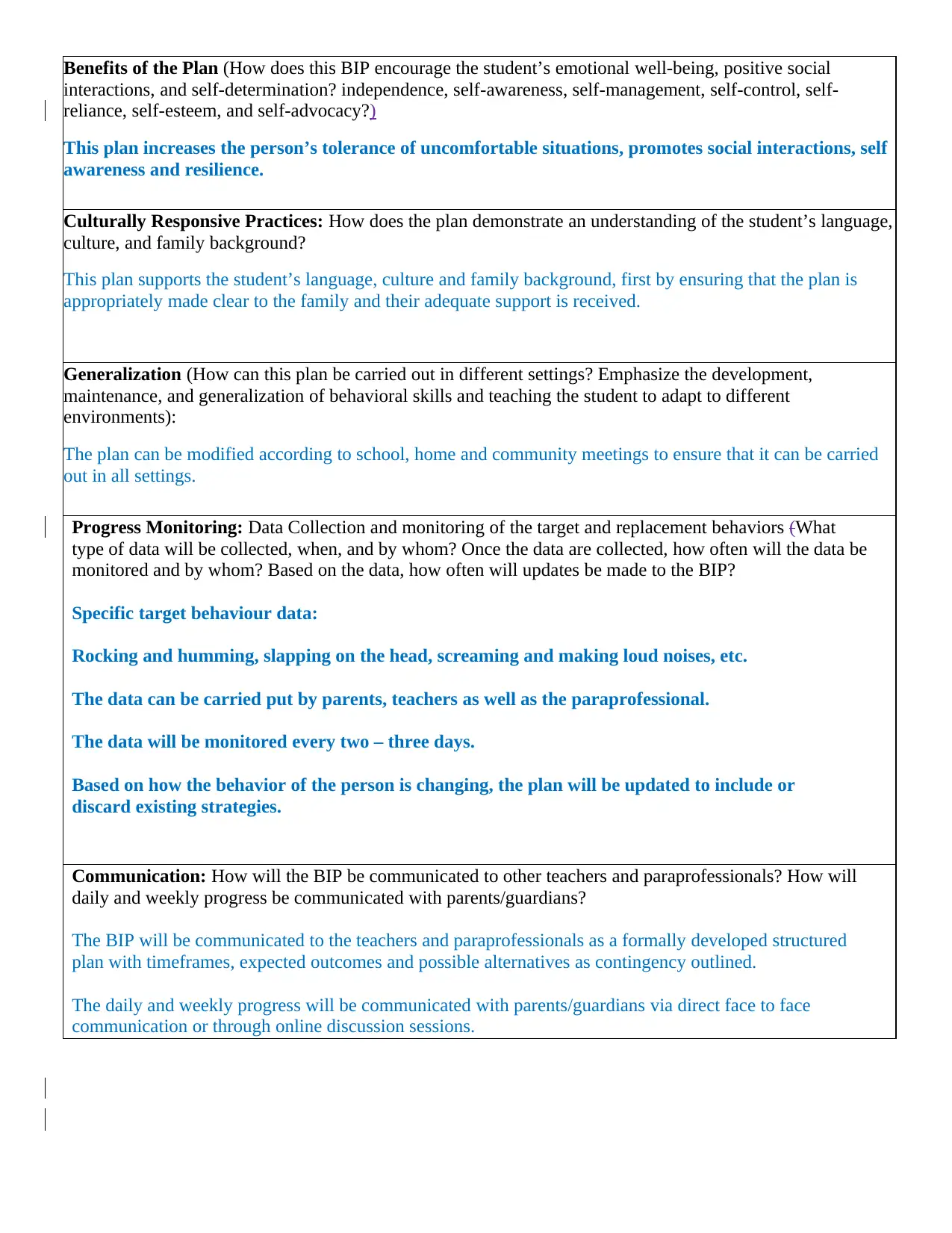
Benefits of the Plan (How does this BIP encourage the student’s emotional well-being, positive social
interactions, and self-determination? independence, self-awareness, self-management, self-control, self-
reliance, self-esteem, and self-advocacy?)
This plan increases the person’s tolerance of uncomfortable situations, promotes social interactions, self
awareness and resilience.
Culturally Responsive Practices: How does the plan demonstrate an understanding of the student’s language,
culture, and family background?
This plan supports the student’s language, culture and family background, first by ensuring that the plan is
appropriately made clear to the family and their adequate support is received.
Generalization (How can this plan be carried out in different settings? Emphasize the development,
maintenance, and generalization of behavioral skills and teaching the student to adapt to different
environments):
The plan can be modified according to school, home and community meetings to ensure that it can be carried
out in all settings.
Progress Monitoring: Data Collection and monitoring of the target and replacement behaviors (What
type of data will be collected, when, and by whom? Once the data are collected, how often will the data be
monitored and by whom? Based on the data, how often will updates be made to the BIP?
Specific target behaviour data:
Rocking and humming, slapping on the head, screaming and making loud noises, etc.
The data can be carried put by parents, teachers as well as the paraprofessional.
The data will be monitored every two – three days.
Based on how the behavior of the person is changing, the plan will be updated to include or
discard existing strategies.
Communication: How will the BIP be communicated to other teachers and paraprofessionals? How will
daily and weekly progress be communicated with parents/guardians?
The BIP will be communicated to the teachers and paraprofessionals as a formally developed structured
plan with timeframes, expected outcomes and possible alternatives as contingency outlined.
The daily and weekly progress will be communicated with parents/guardians via direct face to face
communication or through online discussion sessions.
interactions, and self-determination? independence, self-awareness, self-management, self-control, self-
reliance, self-esteem, and self-advocacy?)
This plan increases the person’s tolerance of uncomfortable situations, promotes social interactions, self
awareness and resilience.
Culturally Responsive Practices: How does the plan demonstrate an understanding of the student’s language,
culture, and family background?
This plan supports the student’s language, culture and family background, first by ensuring that the plan is
appropriately made clear to the family and their adequate support is received.
Generalization (How can this plan be carried out in different settings? Emphasize the development,
maintenance, and generalization of behavioral skills and teaching the student to adapt to different
environments):
The plan can be modified according to school, home and community meetings to ensure that it can be carried
out in all settings.
Progress Monitoring: Data Collection and monitoring of the target and replacement behaviors (What
type of data will be collected, when, and by whom? Once the data are collected, how often will the data be
monitored and by whom? Based on the data, how often will updates be made to the BIP?
Specific target behaviour data:
Rocking and humming, slapping on the head, screaming and making loud noises, etc.
The data can be carried put by parents, teachers as well as the paraprofessional.
The data will be monitored every two – three days.
Based on how the behavior of the person is changing, the plan will be updated to include or
discard existing strategies.
Communication: How will the BIP be communicated to other teachers and paraprofessionals? How will
daily and weekly progress be communicated with parents/guardians?
The BIP will be communicated to the teachers and paraprofessionals as a formally developed structured
plan with timeframes, expected outcomes and possible alternatives as contingency outlined.
The daily and weekly progress will be communicated with parents/guardians via direct face to face
communication or through online discussion sessions.
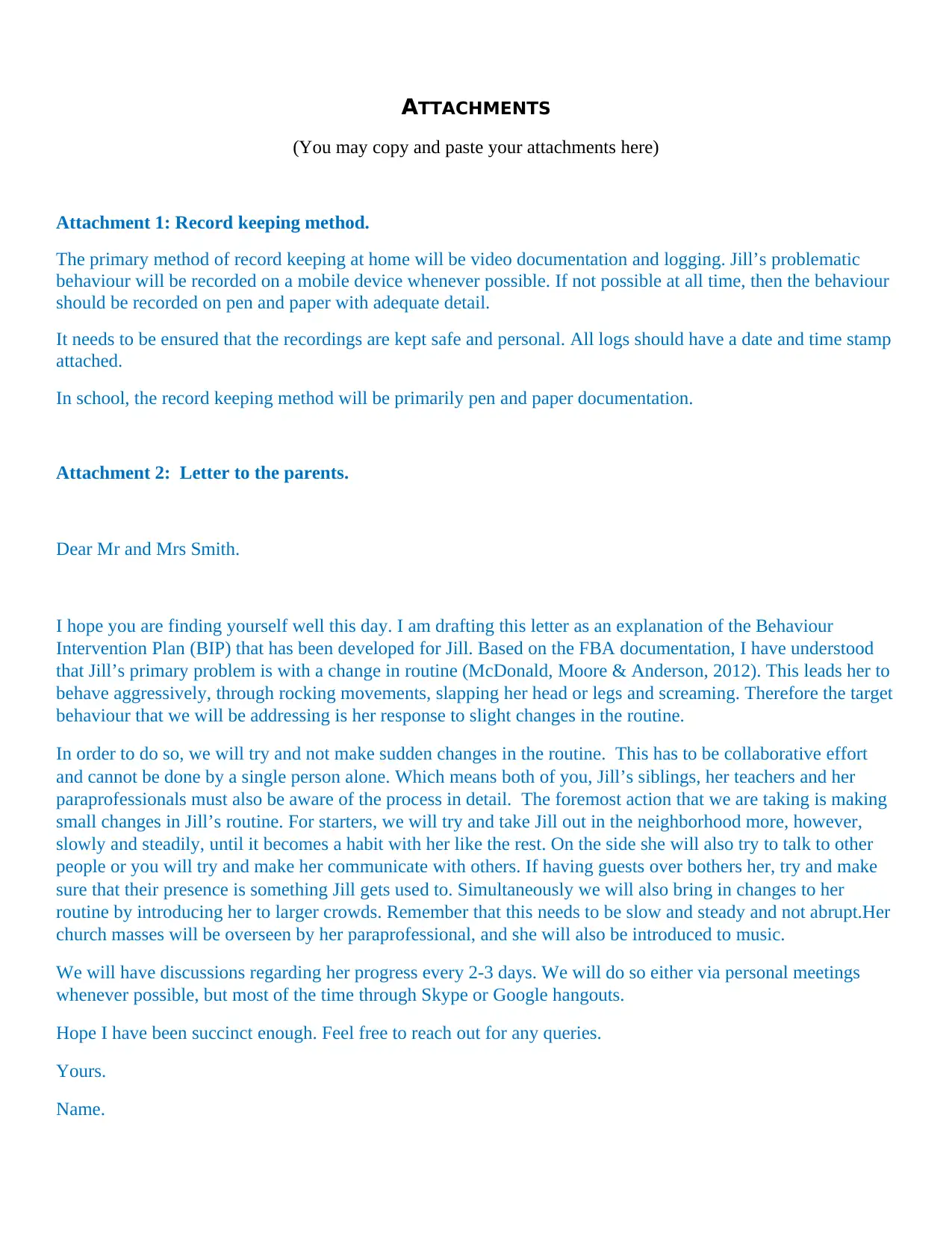
ATTACHMENTS
(You may copy and paste your attachments here)
Attachment 1: Record keeping method.
The primary method of record keeping at home will be video documentation and logging. Jill’s problematic
behaviour will be recorded on a mobile device whenever possible. If not possible at all time, then the behaviour
should be recorded on pen and paper with adequate detail.
It needs to be ensured that the recordings are kept safe and personal. All logs should have a date and time stamp
attached.
In school, the record keeping method will be primarily pen and paper documentation.
Attachment 2: Letter to the parents.
Dear Mr and Mrs Smith.
I hope you are finding yourself well this day. I am drafting this letter as an explanation of the Behaviour
Intervention Plan (BIP) that has been developed for Jill. Based on the FBA documentation, I have understood
that Jill’s primary problem is with a change in routine (McDonald, Moore & Anderson, 2012). This leads her to
behave aggressively, through rocking movements, slapping her head or legs and screaming. Therefore the target
behaviour that we will be addressing is her response to slight changes in the routine.
In order to do so, we will try and not make sudden changes in the routine. This has to be collaborative effort
and cannot be done by a single person alone. Which means both of you, Jill’s siblings, her teachers and her
paraprofessionals must also be aware of the process in detail. The foremost action that we are taking is making
small changes in Jill’s routine. For starters, we will try and take Jill out in the neighborhood more, however,
slowly and steadily, until it becomes a habit with her like the rest. On the side she will also try to talk to other
people or you will try and make her communicate with others. If having guests over bothers her, try and make
sure that their presence is something Jill gets used to. Simultaneously we will also bring in changes to her
routine by introducing her to larger crowds. Remember that this needs to be slow and steady and not abrupt.Her
church masses will be overseen by her paraprofessional, and she will also be introduced to music.
We will have discussions regarding her progress every 2-3 days. We will do so either via personal meetings
whenever possible, but most of the time through Skype or Google hangouts.
Hope I have been succinct enough. Feel free to reach out for any queries.
Yours.
Name.
(You may copy and paste your attachments here)
Attachment 1: Record keeping method.
The primary method of record keeping at home will be video documentation and logging. Jill’s problematic
behaviour will be recorded on a mobile device whenever possible. If not possible at all time, then the behaviour
should be recorded on pen and paper with adequate detail.
It needs to be ensured that the recordings are kept safe and personal. All logs should have a date and time stamp
attached.
In school, the record keeping method will be primarily pen and paper documentation.
Attachment 2: Letter to the parents.
Dear Mr and Mrs Smith.
I hope you are finding yourself well this day. I am drafting this letter as an explanation of the Behaviour
Intervention Plan (BIP) that has been developed for Jill. Based on the FBA documentation, I have understood
that Jill’s primary problem is with a change in routine (McDonald, Moore & Anderson, 2012). This leads her to
behave aggressively, through rocking movements, slapping her head or legs and screaming. Therefore the target
behaviour that we will be addressing is her response to slight changes in the routine.
In order to do so, we will try and not make sudden changes in the routine. This has to be collaborative effort
and cannot be done by a single person alone. Which means both of you, Jill’s siblings, her teachers and her
paraprofessionals must also be aware of the process in detail. The foremost action that we are taking is making
small changes in Jill’s routine. For starters, we will try and take Jill out in the neighborhood more, however,
slowly and steadily, until it becomes a habit with her like the rest. On the side she will also try to talk to other
people or you will try and make her communicate with others. If having guests over bothers her, try and make
sure that their presence is something Jill gets used to. Simultaneously we will also bring in changes to her
routine by introducing her to larger crowds. Remember that this needs to be slow and steady and not abrupt.Her
church masses will be overseen by her paraprofessional, and she will also be introduced to music.
We will have discussions regarding her progress every 2-3 days. We will do so either via personal meetings
whenever possible, but most of the time through Skype or Google hangouts.
Hope I have been succinct enough. Feel free to reach out for any queries.
Yours.
Name.
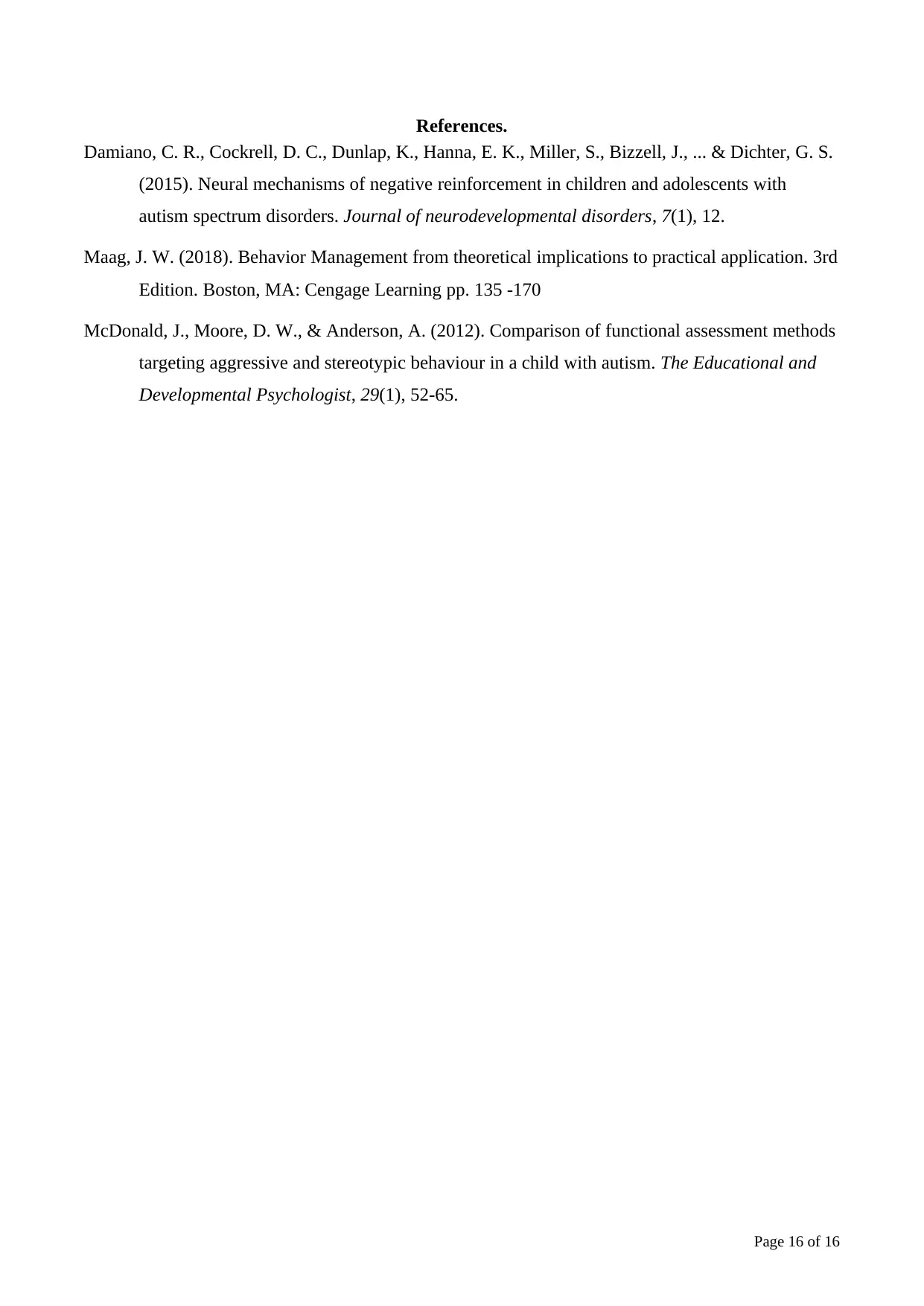
References.
Damiano, C. R., Cockrell, D. C., Dunlap, K., Hanna, E. K., Miller, S., Bizzell, J., ... & Dichter, G. S.
(2015). Neural mechanisms of negative reinforcement in children and adolescents with
autism spectrum disorders. Journal of neurodevelopmental disorders, 7(1), 12.
Maag, J. W. (2018). Behavior Management from theoretical implications to practical application. 3rd
Edition. Boston, MA: Cengage Learning pp. 135 -170
McDonald, J., Moore, D. W., & Anderson, A. (2012). Comparison of functional assessment methods
targeting aggressive and stereotypic behaviour in a child with autism. The Educational and
Developmental Psychologist, 29(1), 52-65.
Page 16 of 16
Damiano, C. R., Cockrell, D. C., Dunlap, K., Hanna, E. K., Miller, S., Bizzell, J., ... & Dichter, G. S.
(2015). Neural mechanisms of negative reinforcement in children and adolescents with
autism spectrum disorders. Journal of neurodevelopmental disorders, 7(1), 12.
Maag, J. W. (2018). Behavior Management from theoretical implications to practical application. 3rd
Edition. Boston, MA: Cengage Learning pp. 135 -170
McDonald, J., Moore, D. W., & Anderson, A. (2012). Comparison of functional assessment methods
targeting aggressive and stereotypic behaviour in a child with autism. The Educational and
Developmental Psychologist, 29(1), 52-65.
Page 16 of 16
1 out of 16
Your All-in-One AI-Powered Toolkit for Academic Success.
+13062052269
info@desklib.com
Available 24*7 on WhatsApp / Email
![[object Object]](/_next/static/media/star-bottom.7253800d.svg)
Unlock your academic potential
© 2024 | Zucol Services PVT LTD | All rights reserved.